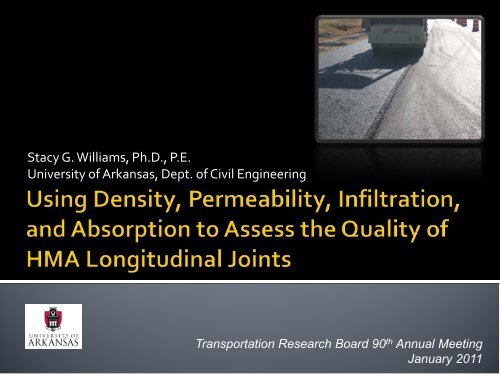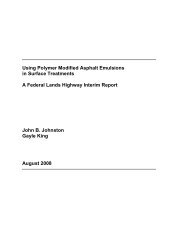HMA Longitudinal Joint Evaluation and Construction - TSP2
HMA Longitudinal Joint Evaluation and Construction - TSP2
HMA Longitudinal Joint Evaluation and Construction - TSP2
Create successful ePaper yourself
Turn your PDF publications into a flip-book with our unique Google optimized e-Paper software.
Stacy G. Williams, Ph.D., P.E.<br />
University of Arkansas, Dept. of Civil Engineering<br />
Transportation Research Board 90 th Annual Meeting<br />
January 2011
1 - 5% lower than mat density<br />
Cold Lane<br />
Hot Lane
• Low Density<br />
• Permeability<br />
• Gradation<br />
• What should<br />
we measure?
• Overlap<br />
• Safety Edge<br />
• Aggregate<br />
Interlock<br />
www.transtechsys.com
• Bond cold <strong>and</strong> hot side of joint<br />
• Reduce permeability
• Polymerized<br />
emulsion<br />
• Penetrates<br />
surface<br />
• Stabilizes joint
• Same as used for mainline paving operations
Hot Lane<br />
Cold Lane
Hot Lane<br />
Cold Lane
Hot Lane<br />
Cold Lane
Nuclear Density<br />
Density –T166 / Absorption<br />
Permeability / Infiltration<br />
Density –T331
• 2 Projects<br />
• 500 ft sections for each of 8 methods<br />
• 3 locations in each section<br />
M<br />
5’<br />
12H<br />
6H<br />
6”<br />
12”<br />
12”<br />
6”<br />
6C<br />
J<br />
12C
Nuclear Density<br />
Density, %<br />
94<br />
92<br />
90<br />
88<br />
86<br />
84<br />
82<br />
12C<br />
6C<br />
J<br />
6H<br />
12H<br />
80<br />
CF CR HO HP JB JH NW TC
Core Density - T166<br />
T166 Density, %<br />
94<br />
92<br />
90<br />
88<br />
86<br />
84<br />
82<br />
6C<br />
J<br />
6H<br />
80<br />
CF CR HO HP JB JH NW TC
94<br />
Core Density - T331<br />
T331 Density, %<br />
92<br />
90<br />
88<br />
86<br />
84<br />
82<br />
6C<br />
J<br />
6H<br />
80<br />
CF CR HO HP JB JH NW TC
8<br />
Core Absorption<br />
Absorption, %<br />
7<br />
6<br />
5<br />
4<br />
3<br />
2<br />
1<br />
6C<br />
J<br />
6H<br />
0<br />
CF CR HO HP JB JH NW TC
8000<br />
Field Permeability<br />
k, cm/s x 10 -5<br />
7000<br />
6000<br />
5000<br />
4000<br />
3000<br />
2000<br />
1000<br />
6C<br />
J<br />
6H<br />
0<br />
CF CR HO HP JB JH NW TC
Infiltration<br />
Infiltration, cm/hr<br />
1400<br />
1200<br />
1000<br />
800<br />
600<br />
400<br />
200<br />
6C<br />
J<br />
6H<br />
0<br />
CF CR HO HP JB JH NW TC
• <strong>Construction</strong> method – significant<br />
• Distance from joint – significant<br />
• Interaction – significant<br />
• Permeability / Infiltration<br />
▪ JB <strong>and</strong> JH – Low permeability at <strong>and</strong> away from the joint<br />
▪ Others – High permeability at joint, lower values away<br />
from the joint
Nuclear<br />
Density T166 T331 Absorption Permeability Infiltration<br />
JH JH JH JB JB JB<br />
NW JB NW JH JH JH<br />
JB NW HO NW NW NW<br />
CR HO TC CR TC TC<br />
HP CR CR CF CR CR<br />
TC TC CF HO HP HP<br />
HO HP HP TC CF CF<br />
CF CF JB HP HO HO
Density vs. Absorption<br />
Absorption, %<br />
8<br />
7<br />
6<br />
5<br />
4<br />
3<br />
2<br />
SSD<br />
y = -0.7336x + 69.352<br />
R² = 0.77<br />
VS<br />
y = -0.3238x + 31.522<br />
R² = 0.54<br />
NG<br />
y = -0.4891x + 47.622<br />
R² = 0.61<br />
SSD<br />
VS<br />
NG<br />
1<br />
0<br />
75 80 85 90 95 100<br />
Density, %
10000<br />
Density vs. Permeability<br />
9000<br />
Permeability, k (cm/s x 10 -5 )<br />
8000<br />
7000<br />
6000<br />
5000<br />
4000<br />
3000<br />
2000<br />
SSD<br />
y = 5E+20e -0.454x<br />
R² = 0.60<br />
VS<br />
y = 4E+10e -0.204x<br />
R² = 0.44<br />
NG<br />
y = 5E+15e -0.326x<br />
R² = 0.55<br />
SSD<br />
VS<br />
NG<br />
1000<br />
0<br />
75 80 85 90 95 100<br />
Density, %
2000<br />
Density vs. Infiltration<br />
1800<br />
Infiltration (cm/hr)<br />
1600<br />
1400<br />
1200<br />
1000<br />
800<br />
600<br />
400<br />
200<br />
SSD<br />
y = 3E+18e -0.417x<br />
R² = 0.58<br />
VS<br />
y = 2E+09e -0.188x<br />
R² = 0.43<br />
NG<br />
y = 1E+14e -0.304x<br />
R² = 0.55<br />
SSD<br />
VS<br />
NG<br />
0<br />
75 80 85 90 95 100<br />
Density, %
2000<br />
Nuclear Density vs. Infiltration<br />
Infiltration (cm/hr)<br />
1800<br />
1600<br />
1400<br />
1200<br />
1000<br />
800<br />
600<br />
poor<br />
4%<br />
abs<br />
fair<br />
2%<br />
abs<br />
good<br />
400<br />
200<br />
0<br />
85 86 87 88 89 90 91 92 93 94 95<br />
Nuclear Density (%)
• <strong>Joint</strong> Heater<br />
• <strong>Joint</strong> Bond<br />
• Notched Wedge<br />
• Rolling Patterns (CR)<br />
• Tack Coat<br />
Best Performers<br />
Not as successful<br />
• Crafco<br />
Unsuccessful
Permeable area near joint<br />
Zone of protection by CF
• Field measures better able to discriminate<br />
quality level than absorption or core density<br />
• Nuclear gauge dependent upon core correction<br />
▪ Gauge seating issues<br />
• Permeability/infiltration not st<strong>and</strong>ard QC tests<br />
• All methods were able distinguish proximity to<br />
the joint<br />
• SSD showed strongest relationship to permeability<br />
▪ Ability to measure low density?
• Use Density as measure of quality<br />
• Already used for QC/QA efforts<br />
• <strong>Joint</strong> Requirements<br />
• 89 percent minimum density<br />
• 4 percent maximum absorption<br />
• Allow contractor to make informed decision<br />
regarding specific joint construction method<br />
• Emphasize the importance of good construction<br />
techniques
• Leela Bhupathiraju<br />
• Alex Lueders<br />
• Annette Porter<br />
• Alan Nguyen<br />
• Mark Greenwood<br />
• Delta Asphalt of Arkansas, Inc.<br />
• APAC-Arkansas, McClinton-Anchor Division<br />
• Heat Design Equipment, Inc.<br />
• TransTech Systems, Inc.<br />
• Southern Star Materials, Inc.<br />
• Pavement Technologies, Inc.
















